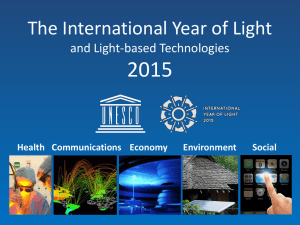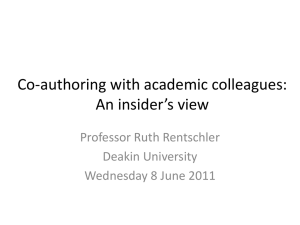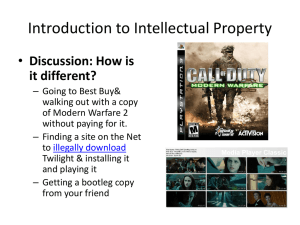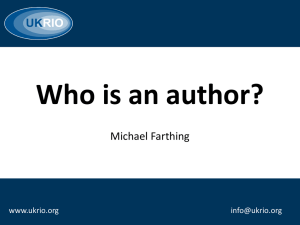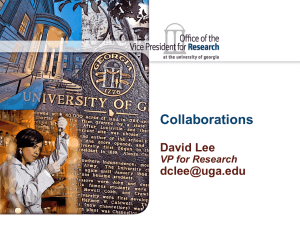Team-based Science
advertisement
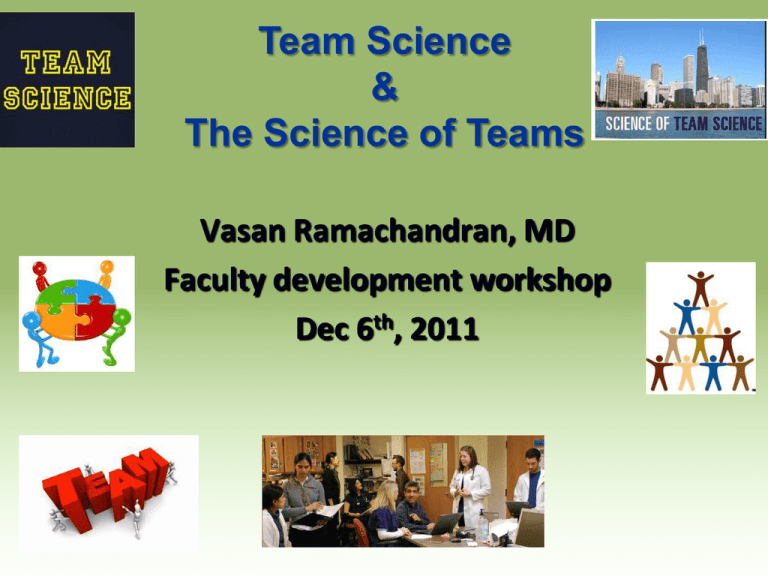
Team Science & The Science of Teams Vasan Ramachandran, MD Faculty development workshop Dec 6th, 2011 Some resources Stokols et al. http://www.nordp.org/assets/resources-docs/rd-talksppt/science_of_team_science-overview.pdf Web sites with team building resources http://www.iamse.org/development/2007/was_103007_files/frame.htm http://www.teambuildingportal.com/articles/systems http://teamscience.nogginlabs.com/upload/launchcourse.php http://www.cals.uidaho.edu/toolbox/workshops.htm Team Building, WHO 2007. available @ www.who.int/entity/cancer/modules/Team%20building.pdf Excellent resource for numerous weblinks and references Tuckman, B.W. & Jensen, M.A.C. (1977) . Stages of small group development revisited. Some books. Stephen Covey. The Third Alternative. Peter Senge. The Fifth Discipline. Deryl Leaming. Managing People. Let’s start at the very beginning.. How many of You… Are part of a team ? Do cross-disciplinary research ? Have a collaboration you are unhappy with? Have had authorship issues on papers ? Team Science Teams & cross-disciplinary research Building a team Challenges to collaboration Conflict in teams Summary Team science : A few observations Team science is an art & a science Teams are made of people They can be only as good as their constituents Teams are intrinsically dysfunctional It can be learnt & must be practiced Things that make teams succeed are the ones that threaten them too! Teams are a lot of fun & contribute to personal & professional growth Team science is a choice: bigger is not always better Some definitions Teams: two or more people working interdependently (collaborating) towards a shared common goal or task Team building: process of gathering the ‘right’ people & getting them to work together to accomplish a goal/task Team management: directing a group of individuals to work as a unit to accomplish a goal/task Groups vs. Teams Members Goals Identity Leadership Products Reward Cohesion Conflict Groups Independent Individual Individual (me) Often single Individual Individual None/limited Reactive Teams Interdependent Shared Shared (we) Shared Collective Collective Esprit Expected/proactive We are evolutionarily programmed for team work ! Teams seem to survive better than individuals ! Evolutionary theory of creativity David Campbell suggests that original ideas come in 3 steps Variation Selection Different kinds of knowledge filter poor ideas & focus on good ones (more efficient) Retention Old practices discarded & replaced by new paradigms Why team science ? Why team science ? Growth of multi-university teams Fastest growing type of authorship structure Produce highest-impact papers when include top university Increasingly stratified by university rank Such social stratification concentrates knowledge production in fewer centers of high impact science Why cross-disciplinary science ? Your funding may depend on it ! Unidisciplinary science is also done by teams 97% of science today is done by teams ! Why cross-disciplinary science ? Diverse Teams Creative Spark Innovation Types of cross-disciplinary research Combines concepts, methods, theories Multidisciplinary Independent, sequential Task force Interdisciplinary Joint, interactive Share ideas over longer time Transdisciplinary Integrative (LeDucq) Shared conceptual product Rosenfield, P. L. (1992). Soc Sci Med, 35, 1343–1357 Team Science Teams & cross-disciplinary research Building a team Challenges to collaboration Conflict in teams Summary Harmony Attachment Support Friendship Excitement, Anticipation Suspicion Getting in Competition Posturing Arguments Elbowing Sorting out Facilitator Working out Starting out Acceptance Friendly Constructive Criticism Participant Modified from: http://www.nwlink.com/~donclark/leader/leadtem2.html Member Director Team Building Stages Role of Leader A Good Team Leader Caters to 2 kinds of needs: Socio-emotional needs Cognitive appraisal of emotional information Understands feelings, responds appropriately Social adeptness Task needs Cognitive Structural Processual Task needs of the Team Leader Cognitive • Inspires • Motivates • Shared vision • Prioritizes • Invites members • Kicks off initial meeting Structural • • • • • Visible Administrative liaison Acquires funding Sets timeline Defines rules of engagement Processual • Defines Processes • Mediates conflict • Secures ‘buy in’ from stakeholders • Negotiates political maze Must have confidence of team Seen as fair, good decision maker, consultative & consensual style, non-hierarchical Humble, human, & role model due to experience Charismatic leaders are not necessarily the best, though charisma always helps ! Selecting team members Complementarity of skills: differentiation & specialization technical executive: problem solving; decision making interpersonal Internationalization & commercialization Cohesion (shared mental model & work) Breeds respect and trust Complementarity conflicts with ‘shared mental model’ !! Selecting ‘Cohesive’ team members Trinity: cognition, attitude, behavior Thinking • knowledge sharing • open-ness • fairness Feeling • • • • Enthusiastic Constructive Supportive Cooperative Doing • • • • Task completion Coordination F/U Monitoring Cohesion builds trust More trustless conflict less bureaucracy & more FUN ! Assembling a team: Questions to ask Team should match research question !!! Skill set (but never forget the generalist) Research fluency Collaborative fluency Leadership experience Core values Compatibility Team Mix Mix of experience & expertise Mix of personality traits (MBTI) ‘go getter’ vs. ‘look before you leap’ Sprinter vs. plodder Risk taker vs. cautious Thinking pattern (HBDI) Creative vs. pragmatic Dreamer vs. logical Spontaneous vs. organized Assembling a team: Correlates Physical proximity helps Tendency for ‘homophily’ (‘ we tend to like people like ourselves’) downside is no ‘creative friction’ essential for good team science Geographic proximity helps 50 meters/30 yard rule Challenge of varying time zones Training locally vs. searching globally Things to assess in teams before starting Collaborative readiness Skill set Experienced leadership Funding Institutional support Software to assess collaborativeness (Collaboration wizard @UCI) Technology to identify collaborators Assembling creative teams Team performance is influenced by 3 variables: Team size % of newcomers in team (is a positive) ! Tendency of incumbents to repeat previous collaborations (is a negative) !! Team assembly mechanisms determine both structure & performance of teams Team Constitution: Network Theory Network typography affects artistic production Combinations of newcomers and incumbents most successful Predominance of incumbents less innovative Shared experiences homogenizes pool of knowledge A person’s network makes a substantial difference in likelihood of success Teams that are not too closely knit nor too pocketed seem to work best Guimera R et al Science 2005 Initial steps to ‘teaming’ Establish vocabulary Evaluate needs of each member ‘Ability-task’ match up Define goals Establish process/decision-making structure Clarify expectations, including authorship Don’t take out the ‘I’ in ‘We’ ‘I’ & ‘We’ are complementary in teamwork ! ‘I’ essential for: Personal development Self esteem Motivation Involvement & performance & quality of work “I” represents belief in self & quest for accomplishment. ‘We’ represents commitment & allegiance to team effort Team communication Face-to-face always best, when possible Videoconferencing (visual cues) Teleconferencing (audio) Intranet Internet E-mail Texting Twitter Why e-mail is imperfect for team science ! Not group memory (comes from one person’s outbox) Fragmented conversation Poor contextualization Assumes common needs same for all members Exclusion of people who are ‘left off’ the list Poor support for creative processes (ranking) Huge volume of non-urgent information Good team meetings Advance notice Concrete agenda Constructive interaction Meeting Listening Speaking Dialogue & healthy debate Decision making Action plan formulated Behavioral patterns in team meetings Don’ts Overly critical Not listening Hogging all attention Talking down Emotional outbursts Interpersonal prejudice Do’s Be objective Unbiased judgment Be tactful & respectful ‘Do unto others’… Interactive 2-way street Appreciate diversity heterophily Sustaining team engagement Recognition Acknowledge collaborators always (headshots in slides) Give students a chance to present Recognize good effort independent of outcome A ‘successful’ project that leads to an unhappy team in not an overall success! Even if project is scientifically unsuccessful, the team may be successful !! Beware of boomerang effects when attempting to change behavior Periodic team engagement Retreats Team-wide attendance at conferences Social team activities Regular meetings to discuss milestones Team Science Teams & cross-disciplinary research Building a team Challenges to collaboration Conflict in teams Summary Paradox of promotion standards in an era of collaborations Traditional Independent work No. of publications PI status First author papers Peer reviewed funding Collaborations Interdependent work Scientific contributions Contributions to multiinvestigator work Mission critical work Leadership in teams Several universities have changed their promotions standards to accommodate contemporary needs for recognizing & rewarding collaborations Big Dog-Small Dog: how junior investigators should approach collaborations Collaborations easier for senior scientists they are not evaluated: can take risks Junior scientists have the ‘time-value’ tension Avoid major responsibilities unless rewards can be clearly negotiated Be aware of promotions criteria Mentor must advocate Team Science Teams & cross-disciplinary research Building a team Challenges to collaboration Conflict in teams Summary Academic Conflict & Sayre’s Law On 20 December 1973, the Wall Street Journal quoted Sayre as: "Academic politics is the most vicious and bitter form of politics, because the stakes are so low." Sayre's law : "In any dispute the intensity of feeling is inversely proportional to the value of the issues at stake." By way of corollary, it adds: "That is why academic politics are so bitter." Wallace Stanley Sayre (1905-1972), U.S. political scientist & professor at Columbia University. Kinds of conflicts in teams Task-related How best to do something Is actually good ! Relationship-related Related to power (PI-ship; authorship) Tone of voice or style Non-sharing of information Authorship conflicts Best avoided by being proactive Decide authorship early on in the project Negotiate but be aware of multiple perspectives; ICJME criteria are rough guide Remember work proportions shift during project There are more projects with same team Clear communication on this issue is key Fair, open, transparent, flexible Authorship conflicts Position, addition, deletion Disagreements are natural part of collaboration; how you navigate disputes makes a difference Upward management for seniors Downward management for juniors Best addressed early Don’t let the sun set on disputes But don’t speak when emotionally charged Authorship conflicts Best addressed face-to-face (no e-mail) Neutral venue best, if possible Prepare for this ‘difficult conversation’ Initially may be uncomfortable Be flexible If face-to-face does not resolve, seek conflict mediation Talk to another mentor you trust Ombudsperson as a last resort Misattribution biases in authorship conflicts Self-serving (ego-centric) bias motivated to see ourselves in a positive light Overestimate contributions to success & underestimate role in failures Availability heuristic Our attribution appears more obvious than others Not easy to take into consideration other perspectives & anchor them in one’s own estimation metric Mentor-mentee conflicts Too little guidance Excess micromanagement Not enough separation Competition Collaboration challenges: some scenarios You do most of the work, senior author wants credit: in publications, in press, in national committees Who will lead the follow-up work after initial ‘home run’? Who will be the PI on next grant ? Project with ‘Core’ group & ‘ancillary group’ ! Collaboration challenges: some scenarios Coinvestigator starts leaving you off emails & does not share data ? Your collaborator promises, but does not deliver Different groups disagree on who should be the first / last author on a manuscript: Group 1: phenotypers; group B: genotypers & PI. Team Science Teams & cross-disciplinary research Building a team Challenges to collaboration Conflict in teams Summary Secrets to ‘winning’ teams Mission clarity and faith (overall) Goal clarity (project-specific) Shared mental model What and by when Appropriate mix of skill sets to address question at hand, including good leadership Role clarity Identification & matching Who does ‘what, when, how, why’ Good communication Secrets to ‘winning’ teams Cohesion & knowledge sharing Process clarity (ground rules) Performance metrics clear Recognition & reward Feedback mechanisms Conflict averting and resolution Appraisal/evaluation mechanism Ongoing team building activities Funding, resources, institutional support

